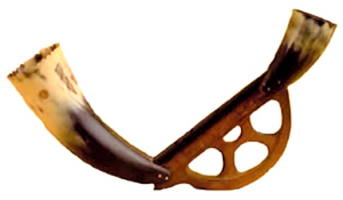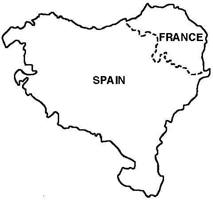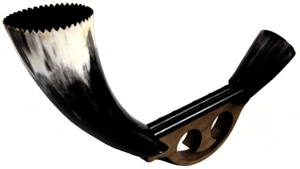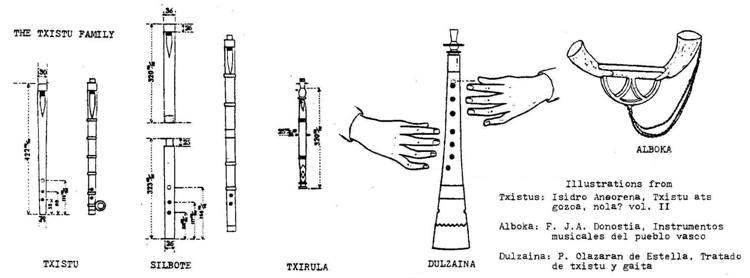
|
The Society of Folk Dance Historians (SFDH)
Basque Musical Instruments
[
Home |
About |
Encyclopedia | CLICK AN IMAGE TO ENLARGE |

|
 While the Basque language is different from any other language stock, and the dances are very Iberian, the musical instruments are quite similar to other European folk instruments.
While the Basque language is different from any other language stock, and the dances are very Iberian, the musical instruments are quite similar to other European folk instruments.
ACCORDION
 The accordion is a popular instrument currently found throughout the Basque region.
The accordion is a popular instrument currently found throughout the Basque region.
ADAR
 The "adar," or ox horn, is still used today for signaling. It is a horn (or trumpet) made out of the horn of an ox, very much like the "shofar" used by the Hebrews, which is made of a ram's horn. It can be used to signal from one hill to another, or when it is time to bring in the animals, or in contemporary times, it has been used to signal that a dance is about to begin.
The "adar," or ox horn, is still used today for signaling. It is a horn (or trumpet) made out of the horn of an ox, very much like the "shofar" used by the Hebrews, which is made of a ram's horn. It can be used to signal from one hill to another, or when it is time to bring in the animals, or in contemporary times, it has been used to signal that a dance is about to begin.
ALBOKA
 The "alboka" (see photo above) is a double-chantered, bagless bagpipe. There are two pieces of cane, side by side, in a single stock, with a horn used as a bell. The mouthpiece is another horn in which are located the two single reeds which are similar to the Bulgarian or Macedonian bagpipe reeds. The player makes an airtight seal with his lips on the inside of the mouthpiece, and circular-breathes (blows constantly, while breathing through his nose). Although previously used in other Basque areas, today, it is primarily used only in the Vizcaya region, to accompany the Jota. It can be played either as a solo instrument, or it can be accompanied by a tambourine (with a leather skin across it), or with "palitos" (two short sticks that are played like spoons).
The "alboka" (see photo above) is a double-chantered, bagless bagpipe. There are two pieces of cane, side by side, in a single stock, with a horn used as a bell. The mouthpiece is another horn in which are located the two single reeds which are similar to the Bulgarian or Macedonian bagpipe reeds. The player makes an airtight seal with his lips on the inside of the mouthpiece, and circular-breathes (blows constantly, while breathing through his nose). Although previously used in other Basque areas, today, it is primarily used only in the Vizcaya region, to accompany the Jota. It can be played either as a solo instrument, or it can be accompanied by a tambourine (with a leather skin across it), or with "palitos" (two short sticks that are played like spoons).
DULZAINA
 The "dulzaina," is the Iberian zurna or oboe. The Basques only use the "dulzaina" in the regijon of Navarra and Alava, but it is also found in other regions of Spain. It is a double-reeded instrument with a conical bore. Metal bands are used for decoration, as well as to alleviate the cracking wood problems. Unlike the Turkish zurna, the "dulzaina" is not played while circular breathing. There also is a metal plate around the reed, so that the reed is not swallowed while breathing.
The "dulzaina," is the Iberian zurna or oboe. The Basques only use the "dulzaina" in the regijon of Navarra and Alava, but it is also found in other regions of Spain. It is a double-reeded instrument with a conical bore. Metal bands are used for decoration, as well as to alleviate the cracking wood problems. Unlike the Turkish zurna, the "dulzaina" is not played while circular breathing. There also is a metal plate around the reed, so that the reed is not swallowed while breathing.
TXISTU FAMILY
![]() The "txistu" (pronounced CHEES-to) family are instruments that consist of the three-holed flutes. They are similar to the recorder family, but only have three holes for the thumb, index, and middle fingers. The mouthpiece is a whistle-type.
The "txistu" (pronounced CHEES-to) family are instruments that consist of the three-holed flutes. They are similar to the recorder family, but only have three holes for the thumb, index, and middle fingers. The mouthpiece is a whistle-type.
The high-pitched "txistu, or the smaller "txirula," is only played in Soule. When played as a solo instrument, the txistulari will hold the instrument in his left hand and hang a "damboril" (drum) from his left elbow, and beat the drum with a stick held in the right hand. When there are two or more "txistus" playing, however, usually only one will play the drum.
The "silbote," or bass "txistu," is about 1-1/2 times the size of the "txistu" and because of its length, is held using two hands. It is used only in "txistu" bands.
Today, the Txistu Band has become very popular in the cities. It will consist of at least a second "txistu," "silbote," and a snare drum. The violin, popular before the turn of the century, is again beginning to appear. At the present time, small bands are also found throughout the Basque regions, consisting of accordion, trumpet, clarinet, drums, and/or any other band instruments available.
ACKNOWLEDGEMENTS
I would like to thank Candi deAlaiza and Anthony Ivancich for their encouragement and help, without which I would not have had the opportunity to become involved in this very interesting music.
DOCUMENTS
- Basque Country, a region.
- Basque Jota, an article.
- Basques, a culture.
- Basques and their Dances, an article.
- France, a country.
- Spain, a country.
Printed in Folk Dance Scene, December 1978.
This page © 2018 by Ron Houston.
Please do not copy any part of this page without including this copyright notice.
Please do not copy small portions out of context.
Please do not copy large portions without permission from Ron Houston.
